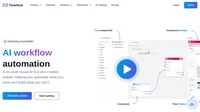OpenAI is a leading artificial intelligence research organization headquartered in San Francisco, California. Founded in December 2015, the company aims to develop artificial general intelligence (AGI) that is safe and beneficial for humanity. OpenAI is known for its significant contributions to the AI field, including the development of the GPT series of language models and DALL-E, a text-to-image generation model.
History and Timeline
OpenAI was founded by Elon Musk, Sam Altman, Greg Brockman, Ilya Sutskever, John Schulman, and Wojciech Zaremba, with a $1 billion endowment. Initially, the organization operated as a non-profit, emphasizing the importance of open research and collaboration.
Key Milestones
- 2015: OpenAI was officially founded.
- 2016: Released OpenAI Gym, an open-source toolkit for reinforcement learning.
- 2018: Introduced the concept of Generative Pre-trained Transformer (GPT).
- 2019: Transitioned to a for-profit model under OpenAI LP.
- 2021: Launched DALL-E, a generative AI model for image creation.
- 2022: Released ChatGPT, a groundbreaking AI chatbot.
- 2023: Leadership shuffle with Sam Altman and Greg Brockman briefly leaving and then returning to the company.
Mission and Vision
OpenAI’s mission is to ensure that artificial general intelligence (AGI) benefits all of humanity. The organization focuses on responsible AI development to avoid potential misuse and catastrophic outcomes. This vision is supported by a commitment to transparency, safety, and collaboration with other research entities.
Key Products and Offerings
OpenAI has developed a range of products aimed at various applications of AI. Here are some of the most notable ones:
ChatGPT
An AI chatbot that generates human-like text based on user prompts. It is widely used for customer support, content creation, and more.
DALL-E 2
A text-to-image generation model that creates images from textual descriptions. It’s used in creative industries for generating unique visual content.
Codex
An AI model designed to assist with coding tasks. It can generate code snippets and complete functions based on natural language prompts.
Whisper
An automatic speech recognition tool capable of transcribing and translating speech in multiple languages.
OpenAI Gym
A toolkit for developing and comparing reinforcement learning algorithms. It provides a variety of environments to test AI models.
OpenAI API
A developer platform offering access to various OpenAI models, enabling the creation and deployment of AI applications.
Ownership and Leadership
OpenAI began as a non-profit but transitioned to a for-profit model under OpenAI LP in 2019. The organization is controlled by OpenAI Inc., which ensures that the company’s mission aligns with its long-term goals.
Key Figures
- Sam Altman: Co-founder and CEO (briefly left in 2023).
- Greg Brockman: Co-founder and Chairman.
- Ilya Sutskever: Co-founder and Chief Scientist.
- Elon Musk: Co-founder (left in 2018 due to potential conflicts of interest).
Benefits and Ethical Considerations
OpenAI aims to harness the power of artificial intelligence for the greater good. However, the organization also recognizes the ethical implications and potential risks associated with AI development.
Benefits
- Innovation: Accelerates advancements in technology and various industries.
- Efficiency: Automates repetitive tasks, freeing up human resources for more creative work.
- Accessibility: Provides tools and resources for developers and researchers worldwide.
Ethical Considerations
- Safety: Ensures AI systems are developed with safety protocols to prevent misuse.
- Transparency: Maintains openness in research and collaboration.
- Bias Mitigation: Works towards reducing biases in AI models to promote fairness.
FAQs
Q: What is OpenAI’s primary goal? A: OpenAI aims to develop safe and beneficial artificial general intelligence (AGI) for humanity.
Q: How can I use OpenAI’s products? A: OpenAI offers APIs and open-source tools that you can integrate into your applications. Visit the OpenAI API page for more details.
Q: Who are the major stakeholders in OpenAI? A: Major stakeholders include Microsoft, which has invested significantly in OpenAI, and the original founders and investors.
Further Reading
For more in-depth information, you can explore the following resources:
OpenAI Review: Is It the Best AI Solution for You?
Explore OpenAI's advanced AI tools like ChatGPT for businesses, developers & more. Ethical, versatile & user-friendly solutions await you!"



